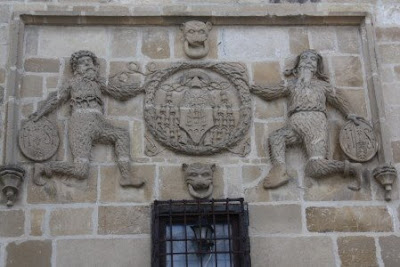The order of our trip, Granada then Sevilla then Córdoba, reversed their order of prominence in Moorish Spain. One or another Moorish prince ruled Granada from the 8th century, but the town had little significance until after the 11th century and achieved prominence primarily during the 250 years in the 13th to 15th century that it was the capital of the Nasrid taifa, the last Moorish kingdom in Spain. Sevilla became the capital of a Moorish taifa kingdom only in the 11th century and was captured by Christian forces in the 13th century.
Córdoba's prominence in Spain, and in the Islamic world, exceeded that of either and Sevilla, and both began and ended much earlier. The Moors, Berber tribes from northern Africa, crossed to Spain in 711 and in eight years conquered most of the Visogothic princes that ruled Spain. In 756, Al ar-Rahman I arrived in Spain from Damascus as the survivor of the Umayyad dynasty that had been ousted from control of the Islamic empire. In Córdoba he established a kingdom that would rule Moorish Spain for nearly three centuries. In 929 Al ar-Rahman III declared himself caliph. Córdoba, as the seat of a caliph, became one of the two principal capitals of Sunni Islam, alongside Bagdad. Under the caliphate Córdoba's population reached 500,000, passing Constantinople as the most populous city in Europe. It became an intellectual center, with perhaps the most advanced culture in the west.
Córdoba's prominence lasted for nearly 300 years, ending in the early 11th century when the caliphate dissolved in civil war and fractured into separate taifa kingdoms. Only after the fall of the Córdoba caliphate did either Sevilla or Granada rise to any prominence.
After arriving in Córdoba, we walked from our hotel toward the heart of old Córdoba and the Mezquita or old mosque (now cathedral) - the primary survivor of Córdoba's Islamic past.
Our path took us past old city walls and gates.


Inside the gate were the white houses

of the old Jewish quarter, which predated the arrival of the Moors and was a center of learning under the caliphate.
The bell tower that

Christians later built to replace the minaret of the Mezquita can be seen from the narrow streets of the Judería.
The Mezquita itself is a large rectangular complex surrounded by crenalated walls supported by buttresses.

Decorated gates pierce the wall. This is the oldest surviving gate.

Others have, or retain, more decoration.

Within the walls is the Patio de los Naranjos.

It now is planted with orange trees, but was once filled with

fountains and cypress, laurel, and olive trees and used and for ritual purification before entering the mosque proper.
A remnant of that past.
The complex is indeed huge - 574 feet long by 420 feet wide. It also is very old. It was begun by Al ar-Rahman I in about 785. In 848 and and again in 961 it was expanded to accommodate the growing number of Islamic faithful. A final expansion in 987 increased its capacity to 40,000 worshipers. It is, or was, one of the largest mosques in the world.
Christian princes conquered Córdoba in the 13th century and converted the mosque to Christian worship. In the 16th century they began to build a cathedral in the middle of the mosque, cutting away columns in the center of the space and raising a higher ceiling with new vaulting. This cathedral sits rather incongruously in the center of the complex, somewhat dwarfed by the size of the old mosque that surrounds it on all sides.
Entering the mosque one plunges into a grid of columns topped with double arches supporting a flat wooden roof. The roof is plain in the oldest section of the mosque, decorated in the newer sections. In all there are over 800 columns - and there were many more before the center was cut out to accomodate the cathedral. Every direction presents perspectives of repeating columns and arches - views down the long prayer aisles created by arches and views through arches across the aisles.




The first expansions of the mosque extended the length of the 11 prayer aisles of the original mosque. The last couldn't add length as the mosque was nearing the river; instead it added new aisles which meant it had to break though what had been an outer wall. Traces of this change are seen here: an arch at the right cut in the old, whitewashed, external wall, with the new aisles beyond, and at the left the remains of an external gate in the wall.

After declaration of the caliphate, the mosque was not only expanded, but sumptious decorations were added. Elaborate gateway arches were added to the central aisle leading to the mihrab, which indicates the direction of Mecca.



Domed cupolas were added above the central aisle to provide light.


A new mihrab, with mosaic decoration appropriate to the mosque of a caliph, was completed in 965.


A room reserved for the worship of the caliph was built in front of the Mihrab and topped with a dome built of intersecting ribs and covered with mosaic.

All this was completed before the year 1000, about 350 years before the Nasrid princes began building their Alhambra palaces - today it stands as the reminder of a great civilization.
That evening we had our best meal of the trip at Bandolero's, a restaurant next to the mosque. We started with salmorejo - a gazpacho typical of Córdoba and dramatically different from the gazpacho we'd had in Sevilla. The pureed tomato base is strongly flavored with garlic and peppery olive oil, and bread crumbs are added to produce a very thick soup; it was served topped with diced Serrano ham and halved, hard-boiled quail eggs. We followed the salmorejo with rabo del toro - chunks of ox tail in a rich, thick sauce. A good end to a good day in Córdoba.





















































